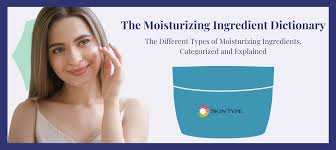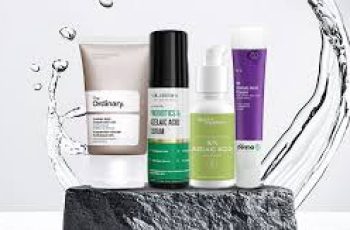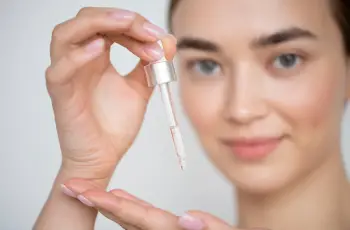
Hydrating and Moisturizing Ingredients List and Dictionary
When it comes to maintaining hydrated skin, the ingredients in your skincare products play a huge role in your skin’s health, softness, resilience, and glow.
There’s no single miracle ingredient that works for every skin type, so combining elements from several moisturizing categories is the key to long-term hydration.
Your skin type—whether oily, dry, combination, sensitive, or acne-prone—will help determine which ingredients work best in your moisturizer.
If you’re unsure of your skin’s needs, a helpful tool like the Baumann Skin Type Quiz can guide you toward the right mix of hydrating ingredients.
Moisturizing ingredients fall into five essential categories: emollients, humectants, occlusives, oils, and fatty acids, each serving a different function in skin hydration.
A good moisturizer will usually contain ingredients from multiple categories to offer both immediate hydration and longer-term barrier support.
Let’s explore each category in detail to better understand how they nourish, protect, and moisturize the skin.
1. Emollients: Smoothing and Softening Ingredients
Emollients are substances that smooth the surface of your skin, making it feel soft, supple, and visually even by filling in gaps between skin cells.
They create a silky, soft finish and can also make skin appear more radiant by enhancing light reflection across the skin’s surface.
Emollients help disguise fine lines and dry patches temporarily and can be beneficial in reducing rough texture in flaky or dry skin.
Popular Emollient Ingredients:
Dimethicone – A silicone-based emollient that offers a silky glide and forms a protective layer without a greasy feel.
Cetearyl Alcohol – A fatty alcohol that conditions and smooths skin, often used in creams and lotions for its creamy texture.
Cyclopentasiloxane – A volatile silicone that feels light and smooth, helping to spread products evenly across the skin.
Some emollients also work as occlusives or humectants, giving them multifunctional benefits in moisturizers for versatile hydration.
2. Humectants: Attracting Moisture to the Skin
Humectants are water-loving ingredients that draw moisture from the environment or deeper layers of the skin into the upper layer of the skin.
These ingredients give skin a plump, dewy appearance and are excellent for hydration when used in humid conditions or layered correctly.
In dry climates, humectants must be combined with occlusives to prevent them from pulling moisture from the skin’s deeper layers, which can lead to dryness.
Popular Humectant Ingredients:
Glycerin – A powerful and widely used humectant that binds water to the skin and enhances moisture retention.
Hyaluronic Acid – A hydrating superstar that can hold up to 1,000 times its weight in water, helping skin stay plump and moisturized.
Urea – A compound with both hydrating and mild exfoliating properties, perfect for dry and flaky skin types.
Propylene Glycol – A synthetic compound used to help draw moisture to the skin and improve ingredient absorption.
Humectants work best when sealed in with a barrier-forming ingredient like an occlusive to keep moisture from evaporating.
3. Occlusives: Sealing in Moisture and Preventing Loss
Occlusives are heavier ingredients that form a protective film on the skin’s surface to lock in water and prevent transepidermal water loss (TEWL).
These ingredients are particularly helpful in dry, cold, or windy environments where skin tends to lose moisture more rapidly.
They work by creating a barrier that prevents hydration from escaping, making them ideal for nighttime routines or those with dry or compromised skin.
Popular Occlusive Ingredients:
Petrolatum (Petroleum Jelly) – An extremely effective occlusive that prevents nearly 99% of water loss when applied to the skin.
Beeswax – A natural occlusive that forms a breathable film on the skin, providing protection without completely blocking pores.
Dimethicone – Besides being an emollient, this silicone-based ingredient also forms a gentle, water-resistant barrier on the skin.
Lanolin – A waxy substance derived from sheep’s wool that helps soothe, soften, and protect the skin while sealing in moisture.
Coconut Oil – While technically an oil, its thick texture gives it strong occlusive properties that help lock in hydration.
Occlusives are ideal for dry patches, cracked skin, and overnight care routines when skin needs intense hydration and protection.
4. Oils: Nourishing Moisture from Natural Sources
Oils deliver essential fatty acids to the skin, which help reinforce the skin barrier, nourish the skin, and provide deep moisture.
They’re occlusive by nature, offering both sealing and emollient properties to improve the feel and function of the skin.
However, some oils can be comedogenic (pore-clogging), so oily or acne-prone skin types should choose non-comedogenic oils.
Popular Oil Ingredients:
Argan Oil – Rich in omega fatty acids and vitamin E, this lightweight oil offers hydration, repair, and anti-aging benefits.
Jojoba Oil – Mimics the skin’s natural sebum and helps regulate oil production while keeping the skin soft and balanced.
Olive Oil – A rich source of antioxidants and essential fatty acids, olive oil hydrates and helps reduce skin inflammation.
Rosehip Oil – High in linoleic acid and vitamin A, rosehip oil supports cell regeneration and improves tone and texture.
Coconut Oil – Provides intense hydration and antibacterial benefits, though it may clog pores in acne-prone skin types.
Use oils strategically based on your skin’s tolerance and needs—lighter oils for oily skin, richer ones for dry or mature skin.
5. Fatty Acids: Building Blocks of the Skin Barrier
Fatty acids are vital for restoring and maintaining the skin’s lipid barrier, which keeps moisture in and irritants out.
They help skin stay smooth, flexible, and less prone to flaking, irritation, and inflammation, especially in dry environments.
Most fatty acids are found in oils and butters and are often combined with other moisturizing ingredients in formulations.
Popular Fatty Acid Ingredients:
Linoleic Acid – An essential omega-6 fatty acid that helps reduce inflammation and strengthens the skin’s moisture barrier.
Oleic Acid – A deeply moisturizing fatty acid found in olive oil, great for dry and aging skin types.
Stearic Acid – A saturated fatty acid that acts as both an emollient and emulsifier, giving products their creamy consistency.
Lauric Acid – Found in coconut oil, lauric acid offers moisturizing, antimicrobial, and balancing benefits for the skin.
Fatty acids help prevent moisture loss, promote healing, and contribute to smooth, resilient, and well-moisturized skin.
The Natural Moisturizing Factor (NMF): Nature’s Skin Hydrator
The Natural Moisturizing Factor (NMF) is made up of amino acids and other compounds that occur naturally in the skin and help it hold onto water.
NMF ingredients attract and retain moisture in the outermost layer of skin, helping to prevent dehydration and maintain elasticity.
While NMF itself isn’t added to skincare products, ingredients that mimic its function are commonly used in hydrating formulations.
Key NMF-Mimicking Ingredients:
Pyrrolidone Carboxylic Acid (PCA) – Binds water and enhances the hydration level of the outer skin layer.
Urea – Softens and hydrates the skin, promoting smoother texture while gently exfoliating dead skin cells.
Lactate – Helps maintain a healthy pH level and draws water into the skin.
Histidine, Glutamine, Arginine – These amino acids bind water and support the skin’s hydration network and overall resilience.
Including NMF-boosting ingredients in your routine can dramatically improve your skin’s ability to retain moisture.
How to Choose the Best Moisturizing Ingredients for You
Selecting the right moisturizing ingredients depends on your skin type, environmental conditions, and specific concerns like dryness, irritation, or oiliness.
Most moisturizers will blend humectants for hydration, emollients for softness, and occlusives for sealing, offering a balanced and effective formula.
Top Moisturizing Ingredients to Look For:
Glycerin – Humectant powerhouse that works in nearly all skin types and climates.
Hyaluronic Acid – Ideal for layering under heavier moisturizers or oils to lock in water.
Cocoa Butter and Shea Butter – Rich emollients and occlusives that deeply hydrate and soothe very dry skin.
Squalane and Macadamia Oil – Lightweight oils that replenish skin lipids without clogging pores.
Sunflower and Coconut Oils – Versatile and nourishing, but use coconut oil with caution if you’re acne-prone.
Final Thoughts: Building a Moisture-Boosting Routine
There’s no universal moisturizer that works for everyone, but understanding ingredient functions helps you tailor your routine to your skin’s unique needs.
Use a mix of humectants, emollients, occlusives, oils, and fatty acids to maintain hydration, support the barrier, and promote healthy skin all year round.
For best results, take a skincare quiz or consult a dermatologist to identify your Baumann Skin Type and choose ingredients that align with your skin goals.
Always read ingredient labels and patch-test new products, especially if you have sensitive or acne-prone skin, to avoid irritation or breakouts.
Healthy, hydrated skin begins with the right knowledge—and now, you’re better equipped to make smart, informed skincare choices.


